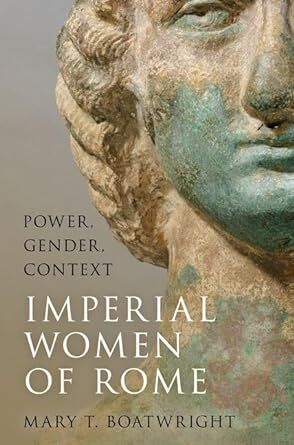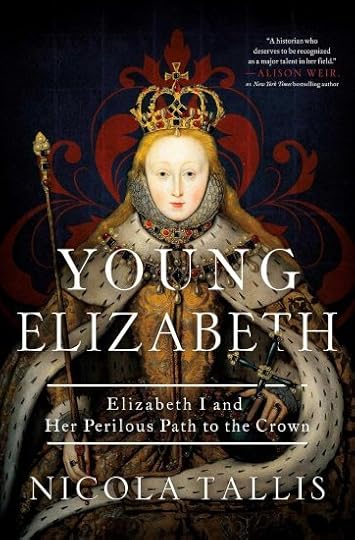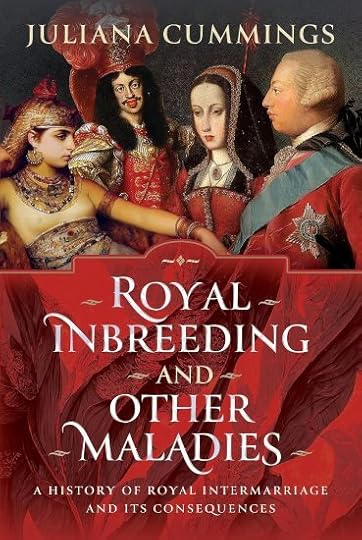Moniek Bloks's Blog, page 56
February 24, 2024
Book News Week 9 2024
Book News week 9 – 26 February – 3 March 2024

Imperial Women of Rome: Power, Gender, Context
Hardcover – 29 February 2024 (US)

Vagabond Princess: The Great Adventures of Gulbadan
Hardcover – 27 February 2024 (US & UK)

The Throne: 1,000 Years of British Coronations
Hardcover – 27 February 2024 (US)

Young Elizabeth: Elizabeth I and Her Perilous Path to the Crown
Hardcover – 29 February 2024 (US)

Kateryn Parr: Henry VIII’s Sixth Queen
Hardcover – 28 February 2024 (UK)

Sisters of Richard III: The Plantagenet Daughters of York
Hardcover – 28 February 2024 (UK)

Royal Inbreeding and Other Maladies: A History of Royal Intermarriage and its Consequences
Hardcover – 28 February 2024 (UK)

Forgotten Women of the Wars of the Roses: The Untold History Behind the Battle for the Crown
Hardcover – 28 February 2024 (UK)

Plantagenet Princesses: The Daughters of Eleanor of Aquitaine and Henry II
Paperback – 28 February 2024 (UK)

On The Trail of Mary Queen of Scots
Paperback – 29 February 2024 (UK)
The post Book News Week 9 2024 appeared first on History of Royal Women.
February 23, 2024
Schloss Nymphenburg & Amalienburg
Schloss Nymphenburg is one of Bavaria’s magnificent palaces.
Construction of the palace was begun by Ferdinand Maria, Elector of Bavaria, and he intended it as a gift for his wife, Henriette Adelaide of Savoy, after the birth of their son, the future Maximilian II Emanuel, Elector of Bavaria, in 1662. It was Henriette Adelaide who decided on the designs of Agostino Barelli.
The main building had a roof by 1672, and the construction of two side pavilions was begun in 1674. Henriette Adelaide passed away in 1676 in the palace as construction was still going on. Her son disliked the palace and halted construction. He also had the side pavillions demolished. It wasn’t until 1701 that he once again took an interest in the palace, and construction continued. However, he, too, would not live to see the building completed.
 The Great Hall © Bayerische Schlösserverwaltung (Photo: Maria Scherf/ Andrea Gruber)
The Great Hall © Bayerische Schlösserverwaltung (Photo: Maria Scherf/ Andrea Gruber)www.schloss-nymphenburg.de
His son, Charles Albert, who later also became Charles VII, Holy Roman Emperor, continued the construction. His son, Maximilian III Joseph, also completed several projects in the Nymphenburg Palace complex. He left no heir and was eventually succeeded by Charles Theodore, who was his 12th cousin, once removed in the male line. Charles Theodore also added his own touches. He was succeeded by Maximilian Joseph of the Palatinate-Zweibrücken-Birkenfeld line, who went on to become the first King of Bavaria.
 © Bayerische Schlösserverwaltung
© Bayerische Schlösserverwaltung(Photo: Andrea Gruber)
www.schloss-nymphenburg.de
Subsequent monarchs continued to add their own touches. King Ludwig I’s Gallery of Beauties was initially collected and installed at the Munich Residence, but it was installed here after the Residence was damaged during the Second World War.
 © Bayerische Schlösserverwaltung
© Bayerische Schlösserverwaltung(Photo: Konrad Rainer)
www.schloss-nymphenburg.de
The palace park also has several constructions, such as the Amalienburg Palace pictured above. This was built between 1734 and 1739 as a hunting lodge for Maria Amalia of Austria, the wife of Charles Albert.
Several other royal women are connected to Schloss Nymphenburg. Princess Alexandra of Bavaria, who had mental health problems, died at the Schloss in 1875. Marie of Prussia gave birth to her eldest son, the future King Ludwig II, at the Schloss in 1845. On 15 April 1891, Louise of Orléans married her second cousin, Prince Alfons of Bavaria, at the Schloss. Duchess Maria Anna Josepha of Bavaria was born there, as were her sisters Maria Antonia of Bavaria and Theresa Benedicta. Princess Sophie of Bavaria, the mother of Emperor Franz Joseph I of Austria, and her twin sister Maria Anna of Bavaria, were born there as well.
Schloss Nymphenburg is open to the public. However, I had mixed feelings during my visit. There is limited information on site, and I suspect most information will be available on the audio guide, which cost extra. I also showed my Munich Card, which was supposed to give me a discount for the admission ticket but this was ignored. The shop itself had quite a few books and souvenirs but it was mostly focussed on Empress Elisabeth and King Ludwig II. There also did not appear to be anywhere to eat on site, although the site does list two restaurants.
The palace itself is gorgeous as are the grounds. You can easily spent a day here. You should definitely include the Marstallmuseum, which is home to the carriages and the porcelain collection.
The post Schloss Nymphenburg & Amalienburg appeared first on History of Royal Women.
February 22, 2024
Queen Mary’s Women of Hampshire Brooch
Queen Mary’s Women of Hamshire Brooch consists of a “pavé-set top with claw-set collet brilliants in the form of a foliage spray, with hinged loop for use as a pendant, suspending three bell-flowers, from which hang a pavé-set baroque pearl and two pear-shaped diamond pendants with open-back settings; the pearl and diamond drops are detachable.”1
Embed from Getty ImagesThe brooch was originally made as a pendant by Garrard. It was given to the future Queen Mary upon her marriage to the then Duke of York by the women of Hampshire. The committee was led by the Duchess of Wellington. Mary wrote her “warmest and most heartfelt thanks for the lovely present… which I shall often wear.”2 Mary later had the pendant converted into a brooch.
Embed from Getty ImagesThe brooch was bequeathed to Queen Elizabeth II in 1953.
The post Queen Mary’s Women of Hampshire Brooch appeared first on History of Royal Women.
February 20, 2024
Queen Kashshaya – The eldest daughter of King Nebuchadnezzar II of Babylon
Queen Kashshaya was the eldest daughter of King Nebuchadnezzar II of Babylon. Historians generally believe that she was queen consort to King Neriglissar of Babylon.[1] While very few facts are known, it is evident that she was a major political player.[2] She owned many estates in Uruk. Her vast wealth and political influence helped shape the events around her.[3] Thus, Queen Kashshaya changed the course of the Chaldean Dynasty forever.[4]
Queen Kashshaya was born in the 6th century B.C.E. Her father was Nebuchadnezzar II. Her mother is unknown. Some historians say that she was Queen Amytis of Media.[5] If this is true, this would make her a relative of King Cyrus the Great, who would one day found the first Persian Empire.[6] Princess Kashshaya had two other known sisters.[7] One of her younger sisters was Princess Ba’u-asitu, who owned a part of an estate in the city of Uruk.[8] The other one was Princess Innin-Etirat.[9] She may have had an unnamed sister.[10] Princess Kashshaya had six known brothers.[11] One of them was Prince Armel-Marduk.
Princess Kashshaya inherited many estates in Uruk.[12] Some of them were crown lands.[13] This made her a wealthy landowner.[14] She also received large quantities of blue wool for garments.[15] A Babylonian document also stated that she freed a slave.[16] Historians generally believe that Princess Kashshaya married Neriglissar, the son of Bel-shum-ishkun (the governor of the Puqudu tribe).[17] Neriglissar also held an important office in Simmagir.[18] This made him a wealthy landowner in Uruk and Sippar.[19] Thus, he was a good match for the eldest of King Nebuchadnezzar II’s daughters.[20] This marriage increased his political influence and wealth.[21] It also paved his way to the throne.[22]
In 562 B.C.E., King Nebuchadnezzar II died. He was succeeded by his son, Amel-Marduk. In 560 B.C.E., King Amel-Marduk reigned for only two years until he was murdered by his brother-in-law, Neriglissar.[23] This left Neriglissar the next King of Babylon.[24] Kashshaya became Queen of Babylon.[25] It is unclear whether Queen Kashshaya produced children with King Neriglissar. Some historians believe that she may have borne Neriglissar an heir named Prince Labashi-Marduk.[26] She may also have given him a daughter named Princess Gigitum, who would later marry Nabu-Shuma-ukin (an influential administrator at the Ediza Temple in Borsippa).[27]
Queen Kashshaya’s later life is unknown. Her death date remains unrecorded. King Neriglissar of Babylon died in 556 B.C.E. He was succeeded by Labashi-Marduk.[28] He reigned for only a few months until he was succeeded by Nabonidus, the last King of Babylon.[29] In 539 B.C.E., King Nabonidus was overthrown by King Cyrus the Great, who founded the first Persian Empire.[30]
Even though very little information is known about Queen Kashshaya, it is clear that she played a major role during the Chaldean Dynasty.[31] As the eldest daughter of King Nebuchadnezzar II, she enjoyed great wealth and privilege. Queen Kashshaya ran many estates in Uruk and crown lands, which helped keep watch over the city that was not fully loyal to the throne.[32] Her significant political influence helped her husband gain the Babylonian throne. Hopefully, new details about this little-known but fascinating Babylonian queen will emerge in the future.
Sources:
Beaulieu, P.-A. (1998). Ba’u-asītu and Kaššaya, Daughters of Nebuchadnezzar II. Orientalia, 67(2), 173–201. http://www.jstor.org/stable/43076387.
Septuagint: Daniel (Vaticanus Version). (1901). United Kingdom: Scriptural Research Institute.
The Cambridge Ancient History: Volume 3 Part 2: The Assyrian and Babylonian Empires and Other States of the Near East, from the Eighth to the Sixth Centuries. (1992). Boardman, J. , Edwards, I. E. S., Hammond, N. G. L., Sollberger, E., Walker, C. B. F. (Eds.). United Kingdom: Cambridge University Press.
[1] Beaulieu, 1998
[2] Beaulieu, 1998
[3] Beaulieu, 1998
[4] Beaulieu, 1998
[5] Septuagint: Daniel (Vaticanus Version), 1901
[6] Septuagint: Daniel (Vaticanus Version), 1901
[7] Beaulieu, 1998
[8] Beaulieu, 1998
[9] Beaulieu, 1998
[10] Beaulieu, 1998
[11] Boardman, et al., 1992
[12] Beaulieu, 1998
[13] Beaulieu, 1998
[14] Beaulieu, 1998
[15] Beaulieu, 1998
[16] Beaulieu, 1998
[17] Beaulieu, 1998; Boardman, et al., 1992
[18] Beaulieu, 1998
[19] Beaulieu, 1998
[20] Beaulieu, 1998
[21] Beaulieu, 1998
[22] Boardman, et al., 1992
[23] Boardman, et al., 1992
[24] Boardman, et al., 1992
[25] Beaulieu, 1992
[26] Boardman, et al. 1992
[27] Boardman, et al., 1992
[28] Boardman, et al., 1992
[29] Boardman, et al., 1992
[30] Boardman, et al., 1992
[31] Beaulieu, 1998
[32] Beaulieu, 1998
The post Queen Kashshaya – The eldest daughter of King Nebuchadnezzar II of Babylon appeared first on History of Royal Women.
February 18, 2024
Book Review: Queen Victoria After Albert: Her Life and Loves by Ilana D. Miller
*review copy*
Queen Victoria was the longest-reigning British monarch until Queen Elizabeth II broke that record. She became Queen just one month after turning 18, and she would reign until her death in 1901 at the age of 81. She married her first cousin, Prince Albert of Saxe-Coburg and Gotha, on 10 February 1840, and they went on to have nine children together. She was very much in love with him, and his early death in 1861 devastated her.
Queen Victoria After Albert: Her Life and Loves by Ilana D. Miller starts with a focus on Queen Victoria, but it takes over 70 pages (about a third of the book) for Prince Albert to die. For a book with the title “Queen Victoria After Albert”, this seems to be rather strange. Then, we get lost in the whirlwind of her children’s marriages and her grandchildren’s marriages. The book also continues to use one of my biggest pet peeves… nicknames for everyone. This seems to be especially prevalent in books about Queen Victoria and her descendants. It makes for a rather confusing book, and it seems to lose its focus on the main subject – Queen Victoria. I did enjoy reading about her relationships with her various prime ministers.
You can tell that the author is knowledgeable, the information is all factual, and there is an abundant amount of footnotes. However, I would say there are better books out there about Queen Victoria.
Queen Victoria After Albert: Her Life and Loves by Ilana D. Miller is available now in the US and the UK.
The post Book Review: Queen Victoria After Albert: Her Life and Loves by Ilana D. Miller appeared first on History of Royal Women.
February 17, 2024
A look at Hereditary Grand Duchess Stéphanie as she turns 40
Born on 18 February 1984, Stéphanie Marie Claudine Christine de Lannoy is the youngest of eight children.
A Belgian noble from birth, Stéphanie was born in East Flanders to Count Philippe de Lannoy and Countess Alix. She attended the Dutch language Sancta Maria de Ronse school before continuing her education at Collège Saint-Odile in France and then at L’Institut de la Vierge Fidèle back in Brussels.
Stéphanie also spent time in Russia studying the Russian language and literature before enrolling at Belgium’s University of Louvain to study German philology. She obtained a master’s degree from Humboldt University of Berlin.
She can speak all the languages of Belgium (French, Dutch and German), as well as English fluently. She also has a good knowledge of Luxembourgish and Russian.
As for her professional career, the Belgian noble interned at the Walloon Export and Foreign Investment Agency and worked for an investment fund company in Brussels.
Embed from Getty ImagesIt was during a 2004 social gathering in Germany that she first met Hereditary Grand Duke Guillaume (the eldest child of Grand Duke Henri and Grand Duchess Maria Teresa of Luxembourg). However, it was not until their second meeting in 2009 that they began dating. Their engagement was announced on 26 April 2012.
Tragedy struck ahead of their wedding as Countess Alix died from a sudden stroke on 26 August 2012 – just two months before her daughter’s wedding.
Embed from Getty ImagesGuillaume and Stéphanie married in a civil ceremony in the Luxembourg Town Hall on 9 October 2012 by Luxembourg City Mayor (and future Prime Minister) Xavier Bettel. A religious ceremony followed on 20 October at the Cathedral of Our Lady of Luxembourg.
Stéphanie wore a bespoke Elie Saab lace gown with her family’s heirloom tiara. As a tribute to her mother, she wore Alix’s engagement ring on her left middle finger to keep her close during the nuptials and reception.
Upon marriage, Stéphanie became the Hereditary Grand Duchess of Luxembourg, became a Luxembourgish citizen and renounced her Belgian citizenship.
She told the media her reason for renouncing her Belgian citizenship was due to her new role: “As the Hereditary Grand Duchess, I am proud to share my husband’s nationality. Belgium will always be the country of my childhood and where my roots are, but I don’t think keeping Belgian citizenship is consistent with the job that awaits me from now on.”
Embed from Getty ImagesPrincess Stéphanie, as she is also called, now joins her husband on foreign trips and has adopted patronages close to her heart, including the arts and those helping victims of strokes. She regularly visits the elderly in Luxembourg with her family as well.
The Hereditary Grand Ducal Couple now have two sons, Prince Charles (b. 10 May 2020) and Prince Francois (b. 27 March 2023).
The post A look at Hereditary Grand Duchess Stéphanie as she turns 40 appeared first on History of Royal Women.
Book News Week 8
Book News week 8 – 19 February – 25 February 2024

Uncrowned: Royal Heirs Who Didn’t Take the Throne
Hardcover – 20 February 2024 (US)
The post Book News Week 8 appeared first on History of Royal Women.
February 16, 2024
Taking a look at Princess Marie Astrid of Luxembourg
Princess Marie Astrid of Luxembourg was born on 17 February 1964 as the daughter of Jean, the then Hereditary Grand Duke of Luxembourg, and Princess Joséphine-Charlotte of Belgium. She was their eldest daughter, and four more siblings, Henri (born 1955), Jean (born 1957), Margaretha (born 1957) and Guillaume (born 1963), followed.
Embed from Getty ImagesHer godparents were Leopold III, King of the Belgians and Charlotte, Grand Duchess of Luxembourg. She received her name in honour of the Virgin Mary and her maternal grandmother, Queen Astrid. She was educated in Luxembourg and Belgium and obtained a nursing degree from the Luxembourg Nursing School in 1974. She became President of the Luxembourg Youth Red Cross in 1970. During the late 1970s, it was rumoured that she was to marry the future King Charles III of the United Kingdom. This would have been unlikely due to differences in religion.
Embed from Getty ImagesOn 6 February 1982, Marie Astrid married her second cousin Archduke Carl Christian of Austria1, who was the grandson of Austria’s last Emperor. It was a grand wedding with many royal guests in attendance. They went on to have five children together: Marie-Christine (born 1983), Imre (born 1985), Christoph (born 1988), Alexander (born 1990) and Gabriella (born 1994). She already has numerous grandchildren.
Embed from Getty ImagesEmbed from Getty ImagesThe post Taking a look at Princess Marie Astrid of Luxembourg appeared first on History of Royal Women.
February 15, 2024
Margaret of Austria – The ailing Archduchess
Margaret of Austria was born on 16 February 1536 as the daughter of the future Ferdinand I, Holy Roman Emperor and Anne of Bohemia and Hungary. She was their ninth child and seventh daughter. She was born in Innsbruck.1
Alongside her sisters Helena and Magdelena, she expressed the wish to stay unmarried. Nevertheless, when Margaret was 14 years old, a plan was floated that saw her marrying her cousin, the future King Philip II. This didn’t happen, and Philip ended up marrying Queen Mary I of England in 1554.2
They founded the Ladies’ Convent of Hall together, but Margaret would not live long enough to move in.
Josef Hirn wrote, “Margaretha had been ailing for years. After an apparent recovery, she became ill again in the summer of 1566. She first sought relief by going to her sister, the Duchess of Bavaria [Anna], and when her condition did not improve, she moved to the Haller Pfannhaus with her two sisters. Here, death ended her suffering.”3
She had been under the care of her personal physician, Dr Merenda, the Bavarian Dr Cortoneus and doctors Schweiker and Alexandrini. Schweiker diagnosed her with a lung disease.4
Margaret died on 12 March 1567.
Her burial took place five days later at the Court Church in Innsbruck. Five years later, she would be transferred to the convent at Hall, where she now rests with Helena and Magdalena.5
The post Margaret of Austria – The ailing Archduchess appeared first on History of Royal Women.
February 13, 2024
Amytis Shahbanu – The aunt and first Queen to Cyrus the Great of the Persian Empire
[Not to be confused with her aunt, Queen Amytis of Babylon]
Amytis Shahbanu was the first Persian Queen of the Achaemenid dynasty. She was the daughter of the last Median king, Astyages. King Astyages was defeated by his grandson, King Cyrus the Great. In order to legitimately procure Media, King Cyrus the Great had to marry his aunt, Queen Amytis.[1] Queen Amytis would play a vital role in queenship in the Achaemenid Persian Empire.[2]
Queen Amytis was born in Ecbatana.[3] She is also called Amytis Shahbanu because Shahbanu was the Persian royal title for Queen.[4] Her birth date remains unrecorded. Her aunt was Queen Amytis of Babylon, who married King Nebuchadnezzar II. Her father was Astyages, the last King of Media.[5] Her mother is unknown. Princess Amytis’s older sister was Queen Mandana of Anshan, who would also be her future mother-in-law.[6] Princess Amytis eventually married Spitamas, a Median nobleman who was also the heir of King Astyages.[7] Princess Amytis bore Spitamas two sons named Spitaces and Megabernes.[8] Therefore, Princess Amytis was meant to be the next Queen of the Median Empire and to continue the royal line.[9]
In 549 B.C.E., Cyrus the Great (the son of Queen Mandana of Anshan and the grandson of King Astyages of Media) defeated his grandfather in battle.[10] In order to merge the Median Empire with his own, King Cyrus the Great killed his uncle, Spitamas, and married his aunt, Princess Amytis.[11] Thus, Amytis became Queen of the Medes.[12] In 559 B.C.E., King Cyrus the Great became King of Persia.[13] Thus, Queen Amytis became Queen of Persia.[14]
There is very little information about Amytis’s life after she became queen consort of Persia.[15] It is unknown if she had any children.[16] The scant historical sources mention that Queen Amytis wielded considerable power during King Cyrus the Great’s reign.[17] Like her sister and mother-in-law, Queen Mandana, she pivoted queens of the Achaemenid dynasty to exercise their real power and authority.[18] She heavily influenced and advised her husband.[19] Thus, Queen Amytis was often seen as a “leader in her own right.”[20] It is assumed that Queen Amytis passed away sometime during King Cyrus the Great’s reign.[21] Princess Cassandane, one of the other wives of King Cyrus the Great, succeeded her as the next Queen of Persia.[22] Queen Cassandane modelled Queen Amytis’s position of power and also exercised her own authority.[23]
While very little is known about Queen Amytis, it is clear that she was a very significant figure in the Achaemenid dynasty.[24] She was meant to inherit the Median Empire with her husband, Spitamas and pass her kingdom to her sons.[25] Instead, she was forced to marry her nephew to legitimise his rule.[26] Queen Amytis must have been politically astute and was greatly respected by her husband.[27] She expanded the role of queenship that her successors would later emulate.[28] It is no wonder that Queen Amytis was considered to be a model queen of the Achaemenid Persian Empire.[29]
Sources:
“Cyrus the Great”. (2011). In L. Rodger, & J. Bakewell, Chambers Biographical Dictionary (9th ed.). Chambers Harrap.
Minsoo, S. (2017). Success strategies in emerging Iranian American women leaders. [Doctoral dissertation, Pepperdine University]. Pepperdine Digital Commons. https://digitalcommons.pepperdine.edu....
Pope, C. N. (2020). The Princes of Persia. (Self-published): DomainOfMan.com.
Schmitt, R. (1989). “AMYTIS”. Encyclopædia Iranica. I/9, p.999 Retrieved 14 July 2023 from http://www.iranicaonline.org/articles....
Venning, T. (2023). A Compendium of World Sovereigns: Volume I Ancient. United Kingdom: Taylor & Francis
Zarghamee, R. (2015). Discovering Cyrus: The Persian Conqueror Astride the Ancient World. United States: Mage Publishers Incorporated.
[1] Venning, 2023
[2] Minsoo, 2017
[3] Venning, 2023
[4] Venning, 2023
[5] Venning, 2023
[6] Schmitt, 1989
[7] Schmitt, 1989
[8] Pope, 2020
[9] Zarghamee, 2020
[10] “Cyrus the Great”, 2011
[11] Schmitt, 1989
[12] Minsoo, 2017
[13] “Cyrus the Great”, 2011
[14] Minso, 2017
[15] Zarghamee, 2020
[16] Zarghamee, 2020
[17] Zarghamee, 2020
[18] Minsoo, 2017
[19] Zarghamee, 2020
[20] Minsoo, 2017, p. 56
[21] Minsoo, 2017
[22] Minsoo, 2017
[23] Minsoo, 2017
[24] Zarghamee, 2020
[25] Zarghamee, 2020
[26] Venning, 2023
[27] Zarghamee, 2022
[28] Minsoo, 2017
[29] Minsoo, 2017
The post Amytis Shahbanu – The aunt and first Queen to Cyrus the Great of the Persian Empire appeared first on History of Royal Women.



